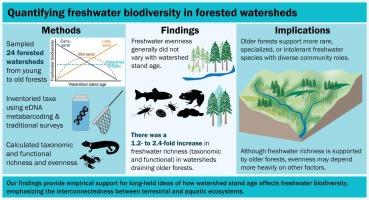森林年龄影响温带流域淡水生物多样性
IF 4.4
1区 环境科学与生态学
Q1 BIODIVERSITY CONSERVATION
引用次数: 0
摘要
森林可以影响河流的结构和功能,但是将淡水生物多样性与流域尺度林分条件联系起来的评价是有限的。通过结合传统和环境DNA (eDNA)方法的脊椎动物和无脊椎动物物种清单,我们评估了关于淡水生物多样性空间格局的相互竞争的假设,这些物种清单涵盖了24个温带流域的年轻森林到老森林(37至124年)。无脊椎动物的淡水分类丰富度和功能丰富度,老林(75年)平均分别比新林高1.2倍和1.5倍,与晚几代假说一致。在较老的森林中,脊椎动物的分类丰富度和功能丰富度分别高出1.6倍和2.4倍,略微支持晚几代假说。总的来说,这些发现表明,不同生境条件下的老森林支持更多稀有、特殊或不耐受的淡水物种,它们具有不同的群落作用。均匀度一般不随流域平均林龄而变化,因此流域内生境多样性可能受到其他因素的影响,如干扰历史、流域特征和景观异质性。然而,通过传统采样测量,无脊椎动物的分类均匀性随着平均流域林龄的增加而下降,这稍微支持了早期的假设,因为年轻的森林可能促进更均匀分布的组合。最终,尽管更丰富的淡水资源得到更古老的森林的支持,但均匀性可能在更大程度上取决于森林流域的其他因素。我们的研究结果为长期以来关于森林与淡水生物多样性之间密切关系的观点提供了实证支持,强调了陆地和水生生态系统之间的相互联系,以及在流域尺度保护中考虑森林的重要性。本文章由计算机程序翻译,如有差异,请以英文原文为准。

Forest age influences freshwater biodiversity in temperate watersheds
Forests can affect stream structure and function, but evaluations linking freshwater biodiversity to watershed-scale forest-stand conditions are limited. We evaluated competing hypotheses about spatial patterns of freshwater biodiversity by combining species inventories of vertebrates and invertebrates from traditional and environmental DNA (eDNA) methods across 24 temperate watersheds of young to old forests (37 to 124 y old). Freshwater taxonomic and functional richness of invertebrates were, on average, 1.2-fold and 1.5-fold higher, respectively, in older forests (>75 y) than in younger forests, consistent with the late-seral hypothesis. Vertebrate taxonomic and functional richness were 1.6-fold and 2.4-fold higher, respectively, in older forests, marginally supporting the late-seral hypothesis. Collectively, these findings suggest that heterogeneous habitat conditions of older forests support more rare, specialized, or intolerant freshwater species with diverse community roles. Evenness generally did not vary with mean watershed stand age, thus the diversity of habitats within a watershed may be shaped by other factors, such as disturbance history, watershed characteristics, and landscape heterogeneity. However, as measured by traditional sampling, invertebrate taxonomic evenness declined with increasing mean watershed stand age, slightly supporting the early-seral hypothesis, as younger forests may promote more evenly distributed assemblages. Ultimately, although greater freshwater richness is supported by older forests, evenness may depend more heavily on other factors in forested watersheds. Our findings provide empirical support for long-held ideas about the tight relationship between forests and freshwater biodiversity, emphasizing the interconnectedness between terrestrial and aquatic ecosystems and the importance of considering forests in watershed-scale conservation.
求助全文
通过发布文献求助,成功后即可免费获取论文全文。
去求助
来源期刊

Biological Conservation
环境科学-环境科学
CiteScore
10.20
自引率
3.40%
发文量
295
审稿时长
61 days
期刊介绍:
Biological Conservation is an international leading journal in the discipline of conservation biology. The journal publishes articles spanning a diverse range of fields that contribute to the biological, sociological, and economic dimensions of conservation and natural resource management. The primary aim of Biological Conservation is the publication of high-quality papers that advance the science and practice of conservation, or which demonstrate the application of conservation principles for natural resource management and policy. Therefore it will be of interest to a broad international readership.
 求助内容:
求助内容: 应助结果提醒方式:
应助结果提醒方式:


